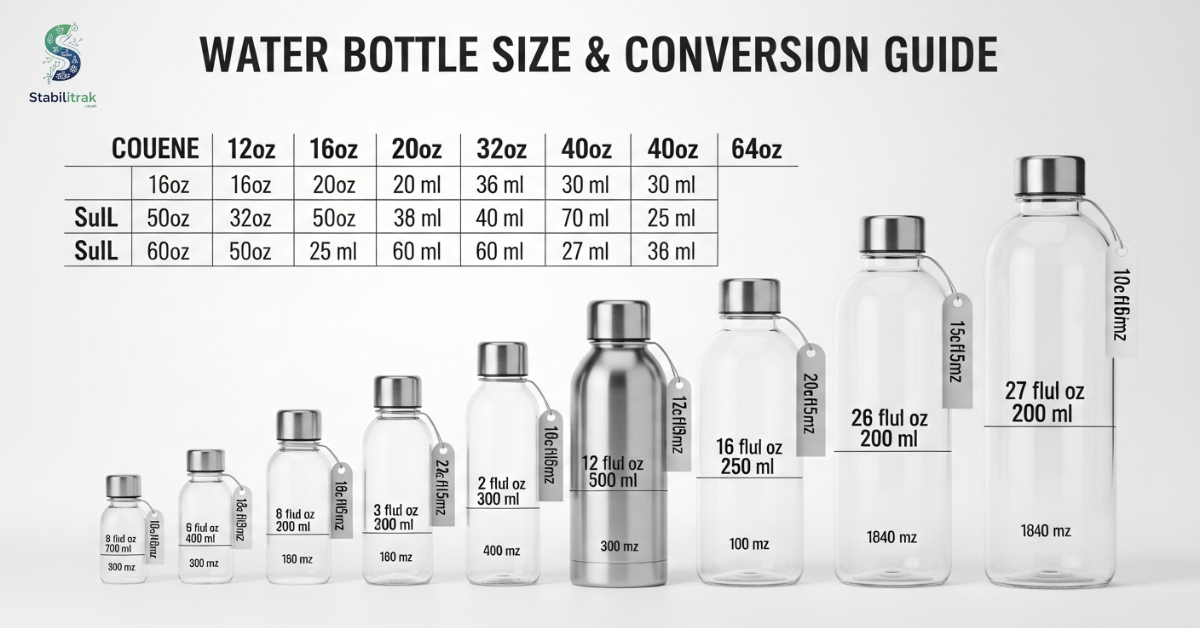Have you ever grabbed a bottle and wondered, “How many ounces are actually in this?” It’s a small detail, but it can be surprisingly frustrating, especially when you’re trying to track your water intake, follow a recipe, or compare drink sizes. Most bottles don’t make it easy, leaving you to guess or search for a clear answer.
In this post, we’ll break down exactly how many ounces are in different types of bottles so you don’t have to second-guess anymore. Whether it’s water, soda, wine, or everyday kitchen use, you’ll find simple explanations and quick conversions to make things easier. By the end, you’ll know the right answer for any bottle size and feel confident keeping track.
What Will Happen If You Drink 135 oz (4L) of Water a Day
Many people wonder if drinking a full 135 ounces of water daily is healthy. That amount equals approximately 4 liters, which may seem like a lot, but it depends on your body, activity level, and climate. For an active adult living in a hot environment, 4 liters may be just enough to stay properly hydrated.
On the other hand, if you’re not very active and already eating water-rich foods like fruits and soups, that much water could feel excessive. You may find yourself needing to use the bathroom more often or experiencing bloating. Moderation and balance always matter more than simply chasing high numbers.
Complications of Overhydration
Drinking too much water can lead to a condition called hyponatremia, where your sodium levels drop too low. This happens because excess water dilutes the natural balance of electrolytes in your body.
Symptoms may include nausea, headaches, confusion, and, in extreme cases, even seizures. While rare, it shows why “more water” isn’t always better. Athletes who constantly drink during long workouts without replenishing electrolytes are at higher risk.
Symptoms of Dehydration
On the flip side, not drinking enough water can cause fatigue, dizziness, dry skin, and darker urine. Even mild dehydration can make it harder to focus or perform physical tasks.
Children and older adults are especially vulnerable. If you feel thirsty, it’s already a sign you’re behind on hydration. Keeping a regular bottle of water nearby helps avoid these dips in energy and concentration.
How Many Bottles of Water Should You Drink Per Day?
The classic 8×8 rule suggests eight 8-ounce glasses daily, or 64 ounces total. But this is only a general guideline. Most experts recommend adjusting based on your weight, activity level, and environment.
For example, if you drink from standard 16.9-ounce bottles (500 mL), you’d need around four bottles to reach 67.6 ounces, which is close to the daily target. If you’re outdoors, working out, or living in hot climates, you may need more.
Read More Article: What Are Godly Parents?
How Many Fluid Ounces in a Tumbler Cup or Water Bottle?
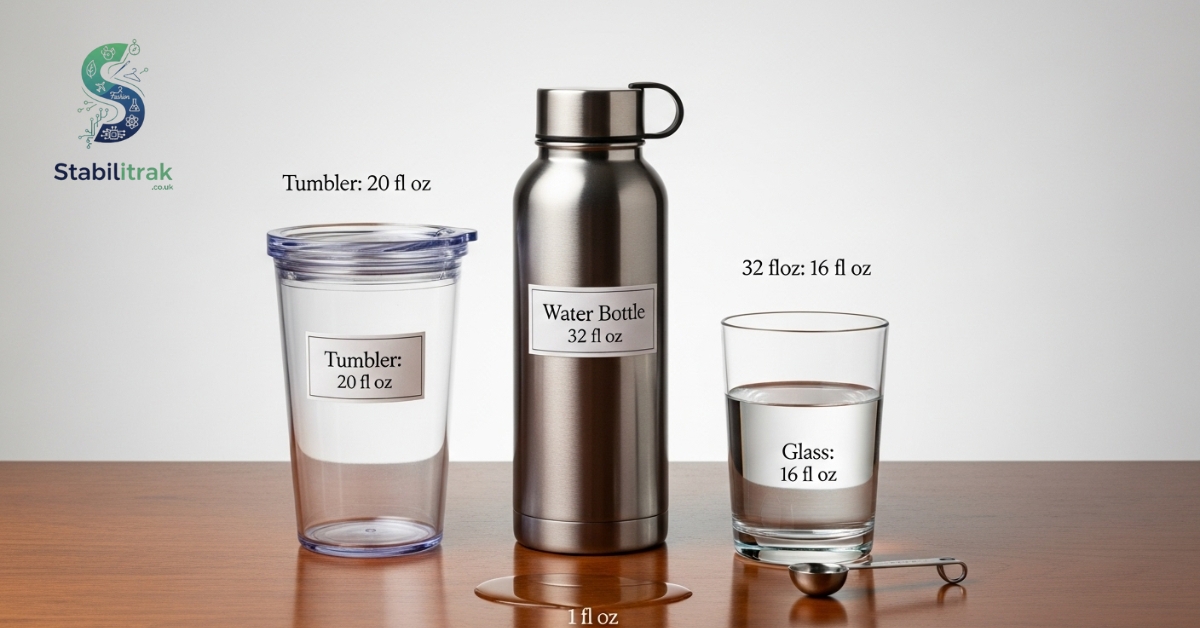
Tumbler cups and reusable bottles vary a lot in size. Some are compact at 12 ounces, while others go up to 40 ounces or more. A common travel tumbler holds about 20 ounces, which is enough to replace a medium-sized disposable bottle.
Reusable bottles are labeled in both milliliters and fluid ounces for convenience. This makes it easier to track daily intake without constantly guessing. When you’re at the gym, for instance, a 32-ounce sports bottle can cover nearly half of your hydration goal for the day.
What Is a Gallon?
A gallon equals 128 fluid ounces. To put that in perspective, it’s the same as about 7.5 standard 16.9-ounce bottles. Many people buy gallon-sized jugs to monitor water intake more easily.
Others prefer half-gallon bottles (64 ounces) for portability. If you’ve seen those trendy large bottles with motivational time markings, they’re usually designed to help people reach that gallon target step by step.
Half-Gallon (or 64-oz) Water Bottle
The half-gallon bottle is popular among fitness enthusiasts. It’s large enough to cover most of your daily hydration needs but still manageable to carry.
Since it holds 64 ounces, drinking two full bottles equals one gallon. For someone with busy workouts, this makes tracking much easier compared to juggling several smaller bottles.
32-oz Water Bottle
The 32-ounce bottle is another favorite because it balances size and portability. It’s small enough to fit in most backpacks yet big enough that you don’t need constant refills.
Two of these bottles give you 64 ounces, matching the 8×8 rule. If you want to hit a gallon, you’ll need four. Many insulated stainless steel bottles are available in this size, making them great for both hot and cold drinks.
25-oz Water Bottle
A 25-ounce bottle is less common but still handy. It equals about three standard cups of water. For many people, one or two refills throughout the day will keep them on track.
This size often comes in sleek, stainless steel designs, making it a stylish choice for office use or travel.
16-oz Water Bottle
The 16-ounce bottle is close to the standard plastic water bottle found in grocery stores. Some are labeled 16.9 ounces (500 mL), which is the most common size worldwide.
These bottles are convenient for kids, short outings, or stocking in the fridge for guests. Since they’re smaller, you’ll need more of them to hit daily goals, but they’re highly portable.
What are the advantages of a stainless steel water bottle?
Stainless steel bottles have become popular because they’re durable, eco-friendly, and often insulated. Unlike single-use plastic, they don’t add to environmental waste and can last for years.
They also keep water cold for hours, which is a bonus for athletes and outdoor enthusiasts. While the upfront cost is higher, the long-term savings and sustainability make them worth it.
What Biodegradable Really Means
Some water bottles are marketed as “biodegradable,” but this term can be confusing. Biodegradable means the material can break down naturally over time, but the process and conditions vary.
Not all biodegradable plastics degrade quickly in landfills. If eco-friendliness is your priority, reusable bottles or those made from recycled materials are better options.
Read More Article: What Not to Eat After Teeth Cleaning
How Many Bottles of Water Should I Drink a Day?
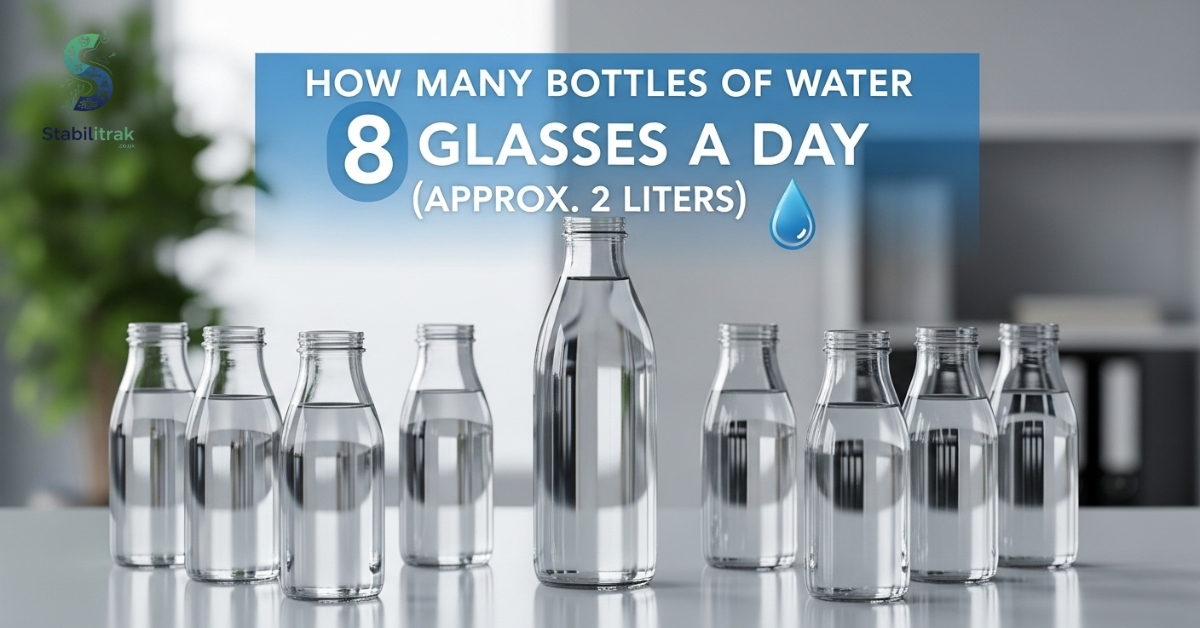
Your daily water needs depend on body weight, climate, and activity. As a quick reference, dividing your weight in pounds by two gives a rough estimate of the number of ounces you should drink.
For example, if you weigh 160 pounds, aim for around 80 ounces daily. That’s roughly five standard 16.9-ounce bottles. Remember, food also provides hydration, so balance is key.
The 8 x 8 Rule
The 8×8 rule—eight 8-ounce glasses daily—remains one of the simplest guidelines. While not scientifically strict, it offers a clear, easy-to-follow baseline.
If you’re using bottles instead of glasses, you can adjust accordingly. A single 16.9-ounce bottle equals about two glasses.
Let’s Convert That To Bottles
Here’s a quick conversion table for daily hydration goals:
| Target Ounces | Standard 16.9 oz Bottles | 32 oz Bottle | Half-Gallon Bottle |
| 64 oz | 4 bottles | 2 bottles | 1 bottle |
| 80 oz | 5 bottles | 2.5 bottles | 1.25 bottles |
| 128 oz (1 gal) | 7.5 bottles | 4 bottles | 2 bottles |
This makes it much easier to track intake without second-guessing.
Don’t forget your spouse and kids’ daily rations.
When planning family hydration, it’s easy to focus only on yourself. But children and partners have their own needs. Kids typically require between 1 and 1.5 liters daily, depending on age and activity.
Packing small 8-ounce or 12-ounce bottles for school can help them stay hydrated without wasting water. For active teens, larger 20-ounce bottles may be more practical.
Here’s What Your Weekly Water Bottle Traffic Looks Like
If you’re drinking four 16.9-ounce bottles daily, that adds up to 28 bottles per week. Multiply that by a family of four, and you’re at 112 bottles.
That’s a lot of plastic if you’re relying on single-use bottles. Switching to reusable options cuts waste dramatically while saving money in the long run.
Three things with the greatest potential impact on your quality of life.
- Daily Hydration – Drinking enough water supports energy, focus, and overall health.
- Reusable Bottles – Reducing single-use plastic helps the environment and your wallet.
- Smart Tracking – Using marked bottles or apps helps you stay consistent with your hydration goals.
These three changes alone can transform your hydration habits.
Water Stockpile Calculator
For emergencies, experts suggest storing one gallon of water per person per day. For a family of four, that means 28 gallons for a week.
If you’re using standard bottles, that’s about 224 bottles of 16.9 ounces. Clearly, larger containers or jugs are more practical for stockpiling.
Read More Article: How Much Does a Tooth Crown Cost?
How Many Bottles Will Your Family Require For The Year?
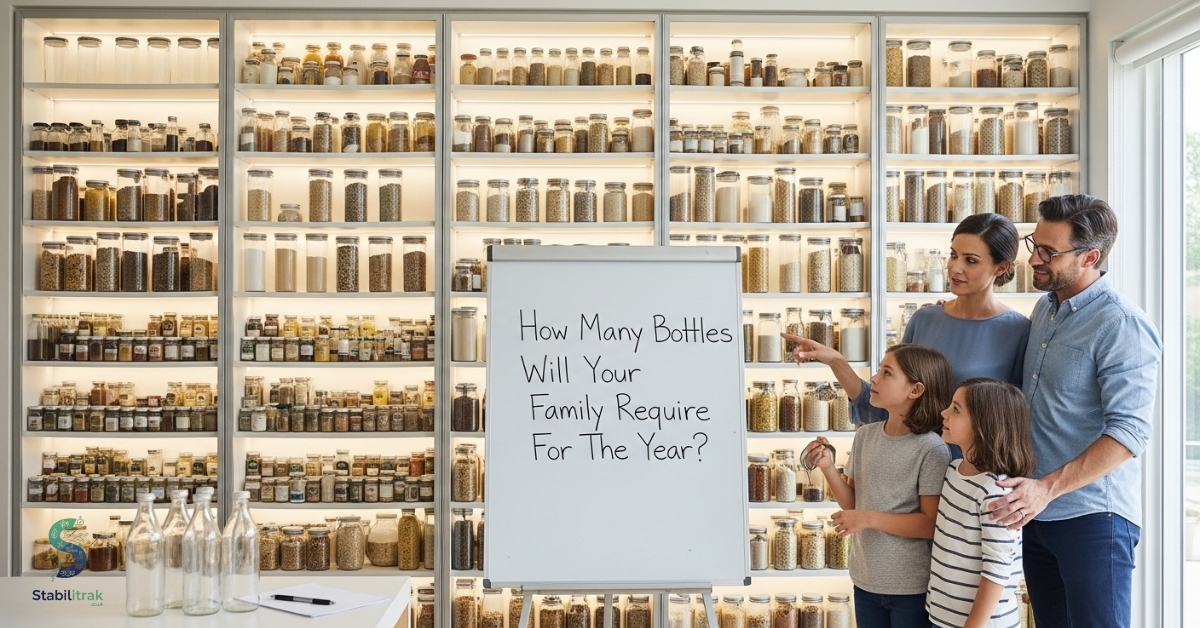
If each person drinks 64 ounces daily, that’s 23,360 ounces per year. Dividing by 16.9 ounces equals about 1,381 bottles per person.
For a family of four, that’s more than 5,500 bottles yearly. No wonder reusable bottles and home filtration systems are growing in popularity.
Introduction to Water Bottle Capacities
Water bottles come in a wide range of capacities, from mini 8-ounce bottles to oversized 64-ounce or even gallon jugs. Each size serves a specific need.
Smaller bottles are perfect for kids or travel, while larger ones suit athletes and people who don’t want constant refills. Understanding capacities helps you choose wisely.
Why Water Bottle Sizes Matter
Choosing the right size isn’t just about convenience. It impacts your hydration consistency, storage needs, and even your environmental footprint.
For example, if you carry a compact 12-ounce bottle, you may refill often but also avoid waste. A half-gallon jug might feel bulky, but it ensures you always have water on hand.
Common Water Bottle Sizes
Most bottled water falls into standard sizes. Here’s a quick rundown:
- 8 ounces (small, kids, or quick servings)
- 12 ounces (compact bottles or cans)
- 16–16.9 ounces (most common grocery store size)
- 20 ounces (sports bottles, vending machines)
- 24 ounces (medium reusable bottles)
- 32 ounces (large reusable bottles, tumblers)
- 40–64 ounces (extra-large bottles for athletes, outdoor trips)
8 ounces
A tiny 8-ounce bottle is often found in hotels, parties, or kids’ lunchboxes. It equals one standard cup of water.
While convenient, you’ll need many of them to meet daily hydration needs.
12 ounces
A 12-ounce bottle is slightly bigger and more satisfying for short breaks. It’s close in size to a standard soda can.
This size often comes with custom labels for events or branding.
16 ounces
The 16-ounce or 16.9-ounce bottle is the world’s favorite. It balances portability and serving size, fitting easily into cup holders and backpacks.
If you buy a case of 24, that’s about 405 ounces total, or just over 3 gallons.
20 ounces
The 20-ounce bottle is common in vending machines and convenience stores. It’s great for workouts or when you need a bit more than the standard size.
This size is also popular for flavored water, sports drinks, and soda bottles.
24 ounces
A 24-ounce bottle is slightly larger and often reusable. It gives you three full cups of water in one container.
For many, this size offers the right balance between portability and capacity.
32 ounces
A 32-ounce bottle equals one quart. It’s a solid choice for people aiming to drink a gallon a day, since only four are required.
Many insulated stainless steel bottles come in this size with features like chug caps or wide mouths.
40 ounces
At 40 ounces, you’re carrying a serious hydration tool. This size is great for long hikes or workdays without access to clean water.
While heavier, it reduces the need for frequent refills.
64 ounces
A 64-ounce bottle covers half a gallon in one go. If you want to track your water easily, two of these bottles will hit the gallon mark.
They’re popular among fitness enthusiasts and people focused on consistent hydration.
Water Bottle Dimensions: Height and Diameter
Bottle size isn’t only about ounces, it’s also about physical dimensions. Smaller bottles usually measure around 7 inches tall, while 32-ounce bottles can be closer to 10–11 inches.
Diameter matters too. Narrow bottles fit cup holders, while wider ones may not.
Measuring the Height of Water Bottles
To measure height, place the bottle on a flat surface and use a ruler from bottom to top. Manufacturers list standard dimensions to help with packaging and labeling.
Height often increases with capacity but varies by design.
Determining the Diameter of Water Bottles
The diameter is the distance across the bottom of the bottle. Slim bottles may be 2 inches wide, while larger ones are closer to 3.5 inches.
This measurement is crucial for fitting bottles into cup holders, backpacks, and vending machines.
How Many Ounces In a Water Bottle
This question depends on the size. A regular water bottle at the grocery store usually holds 16.9 ounces (500 mL). Smaller bottles hold 8 or 12 ounces, while larger ones range from 20 to 64 ounces.
Reusable bottles often come in 25, 32, or 40 ounces for convenience. So the answer really depends on the type of bottle you’re holding.
Conversion Formulas: Ounces to Cups, Inches, and Milliliters
Here are some handy conversions:
- 1 cup = 8 ounces
- 16.9 ounces = 500 milliliters
- 32 ounces = 1 quart (4 cups)
- 128 ounces = 1 gallon
For metric, multiply ounces by 29.57 to get milliliters.
Factors to Consider When Buying a Water Bottle
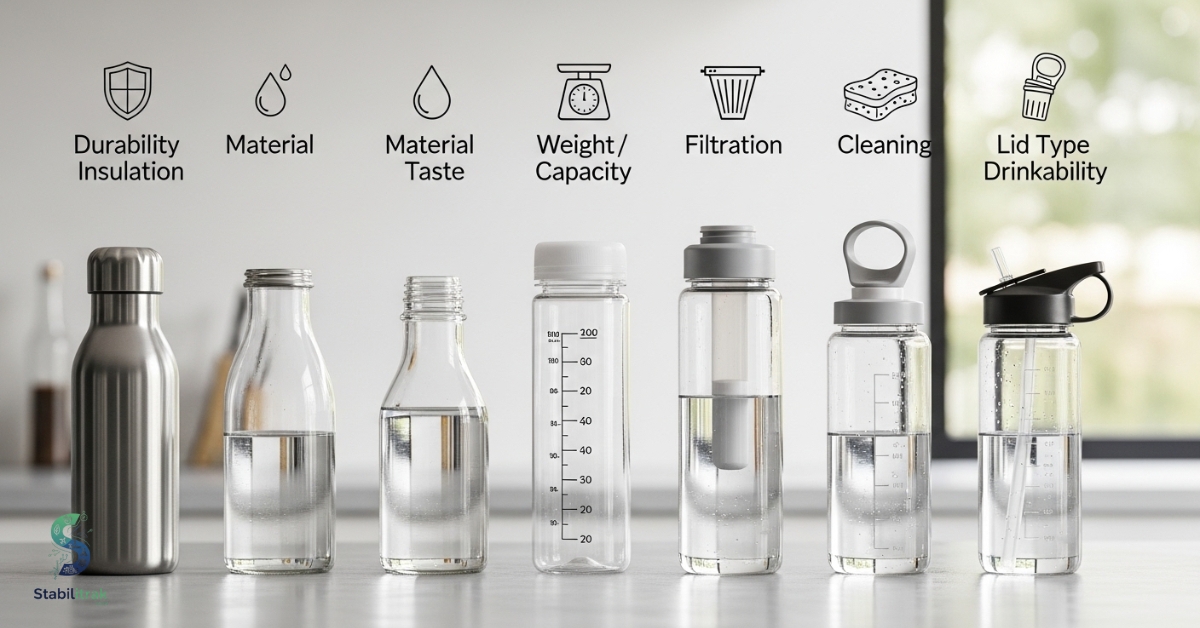
Choosing a bottle isn’t only about capacity. Consider these factors too:
Evaluate the Material Composition
Plastic bottles are lightweight but less durable. Stainless steel is strong and long-lasting, while glass offers purity but can break easily.
Decide on Insulated or Non-Insulated
Insulated bottles keep drinks hot or cold for hours. Non-insulated ones are cheaper and lighter.
Consider Temperature Retention Needs
If you often carry hot tea or cold water, insulation is worth it. For short trips, a standard bottle works fine.
Explore Different Lid Types
Options include screw caps, flip tops, wide-mouth lids, and straw lids. Choose based on convenience and spill-resistance.
Ensure Leak-Proof and Easy-to-Use Features
Nothing ruins a day faster than a leaking bottle in your bag. Look for bottles with proven leak-proof designs.
Consider Customization Options
Custom labels and artwork allow bottles to double as promotional items or personal gifts.
Review the Return Policy for Flexibility
If you’re buying online, a good return policy ensures peace of mind in case the bottle doesn’t fit your needs.
Check Warranty Coverage for Peace of Mind
Many stainless steel bottles now come with lifetime warranties, making them a safe long-term investment.
Find Your Perfect Water Bottle – Splitflask
With so many options available, the perfect bottle depends on your lifestyle. Athletes may prefer 32-ounce insulated bottles, while office workers may want sleek 20-ounce tumblers.
Families benefit from reusable mid-sized bottles to reduce waste, while outdoor enthusiasts often choose rugged, stainless steel designs.
Conclusion
At the end of the day, the answer to “water bottle is how many ounces” depends on the bottle you’re holding. A standard size is 16.9 ounces, but options range from tiny 8-ounce bottles to giant gallon jugs.
Understanding sizes helps you plan daily hydration, reduce waste, and choose bottles that truly fit your lifestyle. Whether you’re sipping from a compact reusable or a large half-gallon jug, the key is consistency. Drink what your body needs, stay balanced, and let the right bottle make hydration effortless.
FAQs
How many ounces is a water bottle?
A standard water bottle usually holds 16.9 ounces (500 mL), though smaller bottles may be 8 or 12 ounces.
Is a water bottle 8 oz?
Some mini bottles are 8 ounces, but most regular grocery store bottles are larger, around 16.9 ounces.
How many liters is 16 ounces?
Sixteen ounces equals about 0.47 liters or almost half a liter.
Is a bottle of water 12 ounces?
Yes, some bottles come in 12-ounce sizes, but they’re less common than the standard 16.9-ounce size.
Is 12 ounces 1 liter?
No, 12 ounces is only about 0.35 liters, so it’s much less than 1 liter.
Is 2 bottles of water a lot?
Two regular 16.9-ounce bottles equal about 34 ounces, which is only part of the daily recommended intake.
What is 40 ounces of water?
Forty ounces equals about 1.18 liters, a little more than a quart.
How much is 12 oz in mL?
Twelve ounces is about 355 milliliters.
Is 500 mL 12 oz?
No, 500 mL equals about 16.9 ounces, not 12.
Is 8 oz 250 mL?
Close, but not exact. 8 ounces equals about 237 milliliters.
What is 40 ounces in mL?
Forty ounces equals about 1,183 milliliters.

